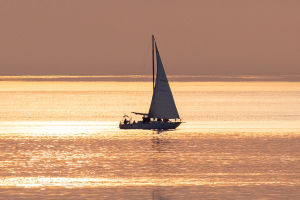Southern Sweden’s region of Skåne turns a bright shade of yellow throughout the spring as the rapeseed fields start to bloom.
The fields of rapeseed are one of the most popular things to see at this time of year. The rapeseed flower, known as raps in Swedish, grows particularly well in the landscape, with it almost being impossible to make a road trip through the region of Skåne without seeing them.
Skåne is one of the most beautiful regions in Sweden, covered in thriving farmland. It is one of the best places for hiking through meadows, picking lavender and enjoying sandy beaches. Rapeseed is a plant that has been grown in this region for years, but only in the 1970s did it become a popular crop as the production of canola oil (rapsolja) began!
Rape, (Brassica napus, variety napus), also called rapeseed or colza, plant of the mustard family (Brassicaceae), grown for its seeds, which yield canola, or rapeseed, oil. Canola oil is variously used in cooking, as an ingredient in soap and margarine, and as a lamp fuel (colza oil). The esterified form of the oil is used as a lubricant for jet engines and can be made into biodiesel. The seeds are also used as bird feed, and the seed residue after oil extraction is used for fodder. The plant can be grown as a cover crop and green manure.
Brassica napus grows to 100 cm (39 in) in height with hairless, fleshy, pinnatifid and glaucous lower leaves which are stalked whereas the upper leaves have no petioles. Brassica napus can be distinguished from Brassica nigra by the upper leaves which do not clasp the stem, and from Brassica rapa by its smaller petals which are less than 13 mm (1⁄2 in) across.
Rapeseed flowers are bright yellow and about 17 mm (21⁄32 in) across.[3] They are radial and consist of four petals in a typical cross-form, alternating with four sepals. They have indeterminate racemose flowering starting at the lowest bud and growing upward in the following days. The flowers have two lateral stamens with short filaments, and four median stamens with longer filaments whose anthers split away from the flower's center upon flowering.
The rapeseed pods are green and elongated siliquae during development that eventually ripen to brown. They grow on pedicels 1 to 3 centimetres (1⁄2 to 1+1⁄4 in) long, and can range from 5 to 10 cm in length. Each pod has two compartments separated by an inner central wall within which a row of seeds develop. The seeds are round and have a diameter of 1.5 to 3 millimetres (1⁄16 to 1⁄8 in). They have a reticulate surface texture, and are black and hard at maturity.
Usually, the rapeseed flowers are in full bloom from the start to the middle of May. This is quite temperature-dependent and some years it comes earlier, and some later! If the winter is mild and spring comes early, you may find that the rapeseed fields bloom as early as April! The rape fields bloom for 2 – 3 weeks in total!
As a rule of thumb, aiming to visit the rape fields at the start of May is your best bet. Of course, if you have the possibility to ask someone living in Skåne how they are looking, or even check Instagram for updates, you are more likely to get a good estimation!
The suburb of Hylle is quite close to Malmö and quite accessible with and without a car! I won’t highlight any specific fields here, but they won’t be hard to spot if you just walk around the area!


